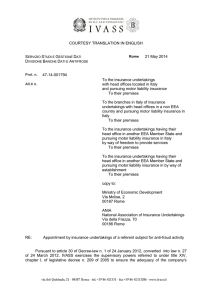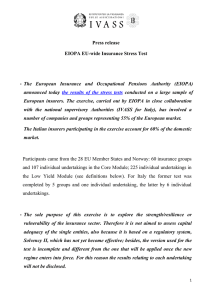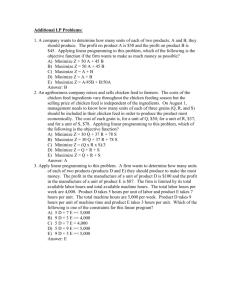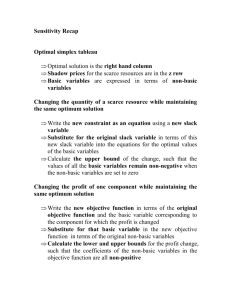The Impact of Alternative Regulatory Regimes on Technical
advertisement
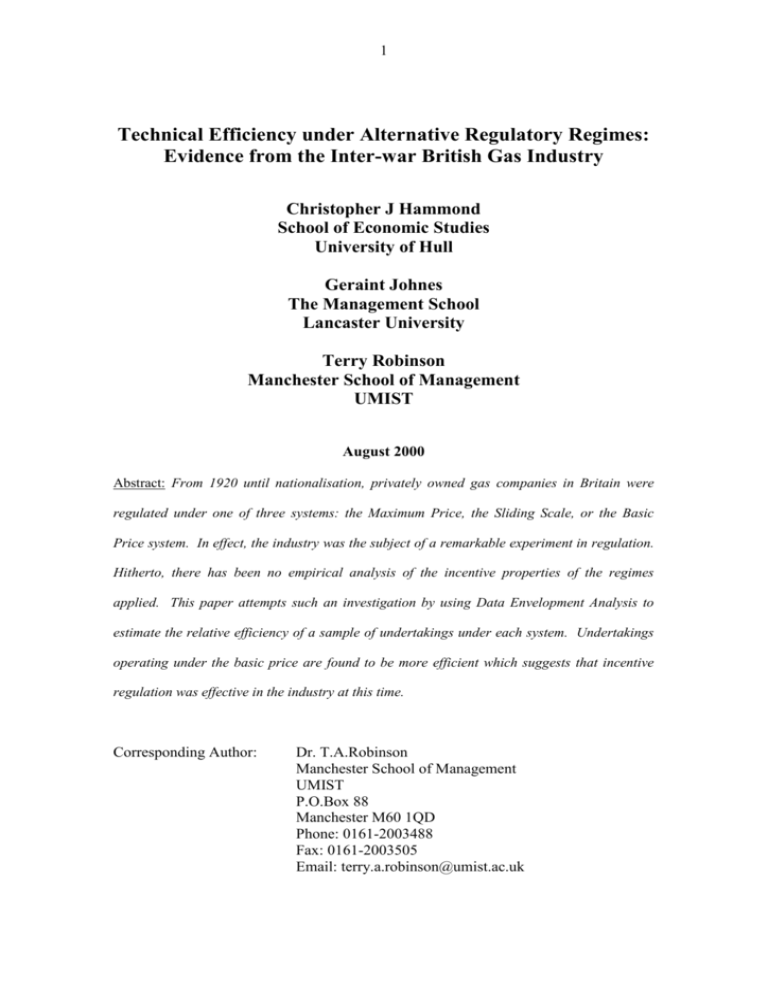
1 Technical Efficiency under Alternative Regulatory Regimes: Evidence from the Inter-war British Gas Industry Christopher J Hammond School of Economic Studies University of Hull Geraint Johnes The Management School Lancaster University Terry Robinson Manchester School of Management UMIST August 2000 Abstract: From 1920 until nationalisation, privately owned gas companies in Britain were regulated under one of three systems: the Maximum Price, the Sliding Scale, or the Basic Price system. In effect, the industry was the subject of a remarkable experiment in regulation. Hitherto, there has been no empirical analysis of the incentive properties of the regimes applied. This paper attempts such an investigation by using Data Envelopment Analysis to estimate the relative efficiency of a sample of undertakings under each system. Undertakings operating under the basic price are found to be more efficient which suggests that incentive regulation was effective in the industry at this time. Corresponding Author: Dr. T.A.Robinson Manchester School of Management UMIST P.O.Box 88 Manchester M60 1QD Phone: 0161-2003488 Fax: 0161-2003505 Email: terry.a.robinson@umist.ac.uk 2 Introduction The construction of effective regulatory regimes by which private network industries can be regulated has been a problem ever since these industries became developed in industrial economies. The problem has become more pressing as country after country has liberalised their network industry. The objective of governments and/or regulatory agencies is to devise a scheme which limits the ability of utility companies to exert their market power, but at the same time provides incentives to produce their services efficiently. The main methods of regulation currently in use are restraints on the rate of return and the price cap. The latter is an example of “incentive regulation”, to the extent that the owners of the firm are able to appropriate, perhaps temporarily, at least part of the benefits of greater efficiency. However, there are alternatives to these two systems, some of which have been implemented, some not. One of these alternatives is a sliding scale or profit sharing system. It is argued that such schemes are more equitable without sacrificing efficiency (Burns, Turvey and Weyman-Jones (1998)). Sliding scale regulation is not a new idea. It was applied to British gas firms, as an alternative to price regulation, as early as 1875 and continued with some changes until nationalisation of the industry after WWII. However, this long experiment in incentive regulation seems to have been largely forgotten or ignored by theorists and policymakers1. This is puzzling, since there has been much theoretical and simulation work by economists on the properties of different regulatory rules. 1 Exceptions are Joskow and Schmalansee (1985) and Turvey (1995). 3 Moreover, although recent empirical studies of the inter-war electricity and 19th Century gas industries in Britain have been undertaken (Millward and Ward (1987), Hammond (1992), Foreman-Peck and Hammond (1997)) there has been no attempt to apply modern quantitative tools to investigate productivity in the gas industry during the inter-war period. In this paper, we attempt to assess the claims for the prenationalisation sliding scale and a variant, the basic price system, that they increased the efficiency of gas firms. To do this we use data envelopment analysis to estimate the relative efficiency of firms under three regulatory devices operating concurrently in the inter-war British gas industry. Our aim is to shed some light on this fascinating episode in regulatory history and to add to the empirical literature comparing regulatory systems. The Pre-Nationalisation British Gas Industry2 The public supply of gas in Britain began in 1812 and there was a rapid entry of supply companies in the years that followed. The industry was extremely competitive with rival firms supplying the same area causing great disruption in the streets, through which as many as three gas mains could be running. At this time, undertakings had to obtain the right to supply by private Bills of Parliament, which usually regulated the level of profit. In the 1860 Metropolis Gas Act, steps were taken to abolish what was seen as wasteful competition. This Act granted the London companies an effective monopoly in their respective areas of supply, an arrangement that was later applied to the whole country. There was a steady expansion of the gas industry throughout the nineteenth century involving both private firms and local authorities. 2 Chantler (1936) provides a more detailed historical outline. 4 Although all gas undertakings produced coal gas, some were also capable of producing water gas. Water gas, produced by blowing steam through red-hot coke in which oil had been vaporised, was first used in order to maintain the illuminating standards imposed on the industry pre-1920. Water gas was injected into the coal-gas stream, thereby enriching the gas to the required illuminating standards. With the abandonment of illuminating standards, the manufacture of water gas became less attractive. However, water gas was still produced on a large scale in 1937 mainly because flexibility in its production, coupled with low labour and capital costs, meant that it could be used as stand by in times of heavy demand. In 1937, the British gas industry supplied almost 1,500 million therms to over eleven million customers. There were over 1,200 gas undertakings of various sizes scattered throughout the country. Of the 712 statutory undertakings in operation, 406 were privately owned and 306 were municipal undertakings. These companies varied considerably in size, organisational form and conditions of operation. The disparity in size is striking. The biggest single undertaking supplied almost 17 per cent of all gas sold in 1937, the ten largest supplied 42 per cent, and the twenty largest more than half. Conversely, all 550 non-statutory undertakings jointly supplied less than 3 per cent of all gas sold. The Regulation of Gas Supply In contrast to other countries where ad hoc commissions or outright public ownership were used to control public utilities, British utility regulation evolved through the mechanism of statutory instruments. The unique privileges and immunities needed for gas undertakings operations’ were granted by Parliament who also imposed restrictions 5 and obligations. At the beginning of statutory control in 1810, legal powers were obtained by Private Act, which was followed in 1870 by a less convoluted system of Provisional Orders. The 1920 Gas Regulation Bill greatly increased the supervisory powers of the Board of Trade. The original Gas Acts imposed no restriction on profits or gas quality and no obligation to supply. It was anticipated that competition would provide the necessary consumer protection and statutory instruments were designed to sustain competitive conditions. The authorities quickly realised that the technical conditions of gas supply made effective competition virtually impossible and so introduced provisions to protect the consumer from monopoly abuse. Limits on dividends were imposed as early as 1818. This restriction was accompanied by the requirement for maximum prices chargeable for gas. However, price limits did not commonly appear in Gas Acts until 1845. Subsequently, a variety of arrangements were adopted and between 1920 and 1945 (when the gas industry was taken into public ownership) there existed three different regulatory pricing rules: the maximum price system, the basic price system and the sliding scale. The Maximum Price System Statutory maximum prices first appeared in 1819 with no adjustment for cost conditions. They were a very ad hoc mechanism with no proper arrangements for revision. From the information available, it is not possible to ascertain exactly how maximum prices were set. In 1868, the City of London Gas Act reduced the maximum price set in the Metropolis Gas Act of 1860 and arrangements for price revision were introduced. The Board of Trade was directed to appoint “three competent and 6 impartial persons” as Commissioners to revise prices (City of London Gas Act, 31 and 32 Vict., Chap. CXXV, Sec. 57). Maximum prices were suspended in 1918 because of the general wartime rise in prices and re-imposed by the Gas Regulation Act 1920, which widened the scope of the London Act by extending the price revision arrangements to all undertakings. Under the act, Gas companies could secure a price increase when gas making costs rose, and local authorities, acting on behalf of consumers, could obtain a reduction in the price chargeable by gas companies when gas making costs fell. By 1937, nearly all of the statutory gas companies came under the 1920 Act. However, the arrangements for the revision of statutory prices were seldom employed. The Sliding Scale Sliding scale regulation was first introduced in Britain in 1867. The basic premise behind the sliding scale was that, to the extent that managerial efficiency is reflected in low prices, it would be rewarded, by allowing firms the right to pay greater dividends. Inefficiency, which was assumed to manifest itself in rising prices, would be penalised by a lower dividend payment. The sliding scale first appeared in the Great Grimsby Act of 1867. The Metropolitan Board of Works proposed a new Bill to regulate the London gas companies in 1875, linking dividends payable to gas charges. Although most of the larger London companies initially refused to take on the new arrangement, by the turn of the century almost half of the statutory companies had adopted the sliding scale.3 3 Starting around 1898 the sliding scale also spread to British electricity supply and distribution companies. 7 Under the original sliding scale, a Standard Price was set administratively. If the company charged a price above (below) the Standard Price its dividend was reduced (increased) according to a prescribed formula. The scheme was introduced at a time of falling prices and took no account of changes in the general price level consequently higher dividends were almost certainly paid with no change in efficiency. Some standard prices were reduced, however, in the late 1890s and early 1900. During the post-1914 rise in prices induced by WWI the opposite problem occurred – standard prices became too low to meet costs. Hence, the system was suspended for two years in 1918. The Gas Regulation Act 1920 restored the sliding scale, with provision for increase by the Board of Trade in the case of cost increases, or on application from the company. The efficacy of the sliding scale was a matter of much contemporary debate with many commentators seeing it as the solution to the “gas price problem” (Turvey, op. cit., p3) while others dwelt on its deficiencies (Bussing (1936)). For our purposes, the system can be seen as a form of incentive regulation. In contrast to the maximum price system, managers arguably had a stronger incentive to keep prices low and hence to make efficiency savings. The Basic Price System In 1920, the South Metropolitan Gas Company introduced the basic price system. The principle was to fix a statutory basic rate of dividend and a basic price for gas. The system then authorised the payment of extra dividends and employee bonuses, equal to a specified proportion of the “consumer’s share”. The latter being defined as the difference between the actual revenue collected for gas sold and a hypothetical basic 8 revenue, or the total amount that would have been collected if all gas supplied to consumers had been sold at the basic price. To give an example: the South Metropolitan Gas Act (1920) fixed a basic price of 11d per therm and a basic dividend of 5%. At the end of the financial year, a sum not exceeding 1/3 of the “consumer’s share” may be divided equally between ordinary shareholders and employee copartners of the company. Say Company A sold 80 million therms at 8d a therm. Total revenue (which depends on the actual price charged) is £2.67m, but basic revenue (which depends upon the basic price) is 80m x 11d = £3.67m. Hence the consumer’s share is £1m and so £333,333 is divided up between extra dividends to ordinary shareholders and bonus payments to employee co-partners. A significant advantage of this system for the companies was that the basic dividend stipulated was a minimum dividend. If firms experienced a sudden rise in costs, under the sliding scale, they would have to raise prices and hence dividends would be cut. It was feared that this could lead to undertakings having difficulties in obtaining funds, especially as gas stocks were seen, as today, as safe investments. In addition, the system provided for a distribution of “surplus profits” with its workers and it was hoped that this would give them a financial interest in making the firm more efficient. However, the main reason why the system was popular with companies was that it made dividends payable contingent on the average price charged for gas, rather than the highest price charged to any consumer as with the sliding scale. Thus, the efficiency calculation included the large volumes of gas sold at discount to industry and at other promotional rates. Consequently, the basic price system permitted a more representative measure of efficiency savings than the sliding scale. Between 1920 and 9 1937, the basic price system was adopted by 36 companies including the large London companies and large provincial companies such as Sheffield and Newcastle. Incentive Regulation Incentive regulation may be defined as “the implementation of rules that encourage a regulated firm to achieve desired goals by granting some, but not complete, discretion to the firm” (Kridel, Sappington and Weisman (1996), p.271). Since network industries such as gas emerged during the 19th Century theoreticians have put forward a myriad of schemes designed to encourage such enterprises to achieve the aim of the regulator.4 The desired goal of Parliament in the period under discussion was clearly lower gas prices. Through its various Acts, the authorities introduced three regulatory plans designed to encourage firms to keep prices below a desired level. There follows a general discussion of the incentive properties of the regulatory systems under investigation. Maximum Price System The maximum price system was introduced in order to prevent monopoly exploitation of consumers. Companies subject to this type of regulation were permitted to make any charge for gas and pay such dividends as the directors may recommend, provided that the prescribed maxima were not exceeded. Since an explicit price cap was set, this scheme has some similarities to present-day price cap regulation. The difference being that there was no systematic examination of undertakings accounts at periodic reviews or attempts to establish a rate base from 4 A brief survey of these designs can be found in Joskow and Schmalansee (1986). 10 which to establish an acceptable rate of return. Nevertheless, inasmuch as the scheme placed a limit on prices it did have the potential to induce greater efficiency. In reality, the maximum price quickly became irrelevant as a constraint on gas firms and the main restriction on prices was the nascent competition from electricity and solid fuels. In 1937, there were 11 million gas consumers and 9 million electricity consumers and most urban properties had both fuels installed. The Sliding Scale In its most general form a sliding scale scheme would involve a firms profits or rate of return deviating from some prescribed “fair” level only if prices differ from a specific level. If profits rise above the “fair” level, then prices must be cut. As will be discussed below, within this overall framework, the scheme could take several forms. More formally, the scheme could be characterised as at = t + (* - t) (1) Here, * is the target (or “fair”) rate of return and t denotes the realised rate of return at the prices current in year t. Consequently, (1) simply shows that the sliding scale would deliver a rate of return, at, reflecting an adjustment parameter, , which is a constant between 1 and 0. Thus, if the realised rate of return fell below * prices are raised in relation to a fraction, , of the difference between the realised rate of return and the target rate. Clearly, the major challenge in implementing a sliding scale scheme is to set *.5 In 1937, * was made operational in the form of the standard price. Under the terms of 5 However, the informational requirements are no more onerous than in many other regulatory schemes, most notably in RPI-X price cap regulation. For more discussion see Burns, Turvey and Weyman-Jones (1995). 11 the 1920 Gas Regulation Act, the standard price could be revised by the Board of Trade in the case of cost increases, on application from the company, or from a local authority acting on behalf of consumers.6 Although the dividend yield sliding scale was in operation in 1937, the general idea could be applied to profits or rate of return.7 Although there is a fairly large literature on optimal regulation under conditions of adverse selection, which highlights the sharing of costs between the regulator and the firm8, the literature on sliding scale regulation is quite small and is contained within broader writings on incentive regulation9. Around 1995, the British Labour Party was understood to be giving serious consideration to a policy involving some type of profit-sharing rule.10 This generated a lot of debate in the media and attracted some academic interest. Mayer and Vickers, (1996) compared a profit sharing rule with the existing system of price caps and found the former unsatisfactory. They argued that profit sharing could increase regulatory instability and noted the serious measurement problems that arise in using profits as a basis for price regulation. In a more recent paper, Burns, Turvey and Weyman-Jones (1998), compare the properties of several regulatory schemes, including the sliding scale, in terms of their productive and allocative efficiency. They found that one particular version of the sliding scale provides identical incentives to productive efficiency as a price cap rule, but is allocatively more efficient. This paper builds on a 6 From the historical literature it is not clear what criteria were used by Board of Trade officials when considering changing Standard prices. More research is needed in this area. 7 The operation and evaluation of these options is described and evaluated by Burns, Turvey and Weyman-Jones, op. cit. 8 For a detailed discussion see Laffont and Tirole (1993). 9 The literature often refers to “profit-sharing” regulation. 10 Once in power the Labour Party quickly abandoned this idea. 12 small body of inconclusive theoretical work considering the welfare implications of sliding scale schemes. Lyon (1996) summarises this literature and finds relative to price caps, some degree of profit sharing always increases expected welfare. Of the historical literature, Turvey (1995) and contemporaneous surveys by Chantler (1938) and Bussing (1936) all agree that the sliding scale offered rewards for greater efficiency which were absent under the maximum price system. Basic Price System As described above the basic price system differs from the sliding scale in two main ways. Firstly, the basic price system was "one-way only", in that dividends did not have to be reduced if prices exceeded the basic price, but could rise if the price was below it. Secondly, there was the general introduction of “co-partnership” under which employees were to benefit from any efficiency gains. Theoretically, this second aspect of the scheme is interesting. The literature on the provision of incentives in firms is vast. Prendergast (1999) presents a recent survey, in which she concludes that, from the evidence collected, it does appear that workers respond to incentives. Most empirical research points to strong effects of pay-for-performance on output. Profit sharing with workers had been introduced into the gas industry as early as 1889. Matthews (1988) describes the evolution of the various schemes up to 1949 and concludes that employee profit sharing had very limited success. Empirical comparisons of different regulatory systems have centred on the telecommunications industry in the United States. This is mainly because of the number and variety of regulatory plans adopted by Local Exchange Companies in 13 different states11. Several papers have examined the productivity effects of a switch from rate of return to some sort of incentive regulation. The evidence is mixed. Shin and Ying (1993) find that there may have been a small increase in costs under incentive regulation. Conversely, Tardiff and Taylor (1993) and Schmalansee and Rholfs (1992) conclude that significant increases in productivity resulted after incentive regulation was introduced. Data In order to test whether there was any difference in technical efficiency under the three regimes we use cross-section data for 1937; a period when there was a fairly even spread of firms operating under each regime.12 The main data source is the “Board of Trade Return Relating to all Authorised Gas Undertakings, 1937” which lists data for 406 privately owned and 300 local authority companies. Apart from the differences in regulatory regime, which are the focus of our study, gas undertakings are also differentiated by their technical production possibilities. As noted above, all gas undertakings produce coal gas, but some also have the capacity to produce water gas. The sample includes 68 undertakings capable of producing both coal and water gas. The output vector therefore has two dimensions reflecting the volume of coal and water gas produced. Inputs to the production process are capital, coal and labour. Coke and oil inputs are also required for the production of water gas. 11 These are catalogued by Kridel, Sappington and Weisman (1996). Bearing in mind the evolution of the regulatory system, outlined above, the regulatory regime under which the producer operates may be endogenous. Unfortunately, we are unable to explore this possibility with our dataset. 12 14 Information on most of these variables was obtainable from the Board of Trade Returns, however this source contains no information on labour costs. Therefore, details of labour costs for 1937 were obtained from the Stock Exchange Yearbook. Unfortunately, this document does not cover the municipal firms so these could not be included in the sample. Usable data on labour costs could be collected for the 117 privately owned firms, which constitute our sample. Data were collected on coal and water gas made (100 cubic feet) and five inputs, capital, labour, coal, coke and oil. The capital variable is mains mileage of the distribution system.13 Labour is measured as total labour costs, coal is coal carbonised in tons, coke is measured in tons and oil used in gallons. Summary statistics for firms under the three regimes are provided in Table 1. (Insert Table 1 here) It can be seen from the table that undertakings under basic price regulation are on average larger than those operating under the sliding scale, which in turn are larger than maximum price undertakings. Undertakings that produce both coal and water gas are larger than those producing only coal gas. Methodology We derive estimates of the efficiency of gas undertakings using Data Envelopment Analysis (DEA). The basic principles of DEA are discussed at length by Boussofiane et al. (1991) and implemented in the Warwick DEA computer software package (Thanassoulis, E & Emrouznejad, A (1996)). 13 In their study of costs in the C19th gas industry, Millward and Ward (1987) construct an index of capital vintage using financial data. The lack of data for our period prevented us using this technique. 15 As its name suggests, DEA is a technique for fitting piecewise linear surfaces that support all the observations of the production process. Thus, we obtain a lower bound representing efficient transformations of inputs into outputs, which in turn, provides a benchmark against which to measure efficiency. DEA is applied at the level of the decision-making unit (DMU), which in our case is a gas undertaking. Each DMU is considered in turn and its efficiency measured by computing the largest feasible radial contraction of its input vector, taking the output vector as a constraint. Each DMU is compared with another DMU in the sample, or a hypothetical DMU, defined as a convex combination of the production plans of other units in the sample. Any excess inputs and outputs are assumed freely disposable. That is, there are no marginal effects associated with inputs or outputs exceeding the minimum required by the efficient production plan. Banker et al. (1984) specify the linear programming problem representing the fitting of an efficient production surface to the data, under variable returns to scale. The DEA framework can be implemented as an output maximisation or input minimisation problem. For our sample of gas undertakings we believe that output should be regarded as exogenously determined, so that an input minimisation framework is most appropriate. Although gas could be (and was) stored to meet variations in demand, many undertakings had explicit strategies to meet peaks in demand from current production rather than stocks, perhaps reflecting their legal obligation to supply on demand. 16 DEA can be performed under the assumption of constant or variable returns to scale. The efficiency index derived under the assumption of variable returns to scale requires an additional constraint on the solution, compared with the constant returns to scale case, with the effect that the resulting efficiency estimate will never be smaller than that obtained under constant returns to scale. Where the alternative approaches yield different efficiency values, the variable returns to scale index takes account of scale related effects and therefore represents pure technical efficiency alone. The constant returns to scale measure represents overall efficiency, in which pure technical and scale efficiency are combined. The index of overall efficiency, obtained by assuming constant returns to scale, is equal to the product of the scale and pure technical efficiency indices (Banker et al. (1984)). Hence, an index of scale efficiency can be obtained by manipulating the DEA results obtained under the assumption of constant and variable returns. Following Banker (1984), the local returns to scale properties of the technology can be determined by aggregating the weights applied to the peer DMUs in constructing the hypothetical production plan used in the calculation of efficiency. Given the multi-dimensional nature of the production process, the efficiency index derived by radial contraction of the input vector may not always identify a fully efficient production plan. Further (non-radial) contraction of a subset of inputs may be possible, without sacrificing outputs. These can be identified as input slacks. Empirical Findings 17 Table 2 summarises the technical and scale efficiency indices for each of the regulatory regimes. (Insert Table 2 here) Comparing average efficiency for each regime, we can see that the patterns in technical and scale efficiency are identical, with firms operating under the basic price system being the most efficient and those under the maximum price system the least. The "average efficiency" index is, of course, influenced by the number of fully efficient observations in the sample/subset. The number of technically efficient undertakings is recorded in the table. The row labelled "Proportion of Efficient Undertakings in Sample" summarises the distribution of technically efficient undertakings over the three regulatory regimes. These data indicate that an undertaking selected at random from the subset of fully technically efficient observations is most likely to be operating under the sliding scale regime and least likely to be one subject to maximum price regulation. However, these patterns must be considered in the context of the distribution of the sample observations over the three regimes. One way of contextualising these data is to compare the distribution of efficient undertakings with that which would be expected if efficiency were independent of the form of regulation (i.e. equiprobable under all three regimes). Comparing the distribution of technically efficient undertakings and of the sample observations over the three regimes, we note that technically efficient undertakings are observed less frequently than expected under the sliding scale regime (46%, compared with 59%) 18 and more frequently than expected under the basic price regime (32%, compared with 20%). Alternatively, we might consider the efficiency of a firm drawn at random from the subset of observations operating under a particular regulatory regime. The proportion of technically efficient plants in each subset may then be interpreted as an indicator of the propensity to efficiency, among firms subject to that regulatory regime. The row labelled "Proportion of Efficient Undertakings by Regulatory Regime" indicates that firms operating under the basic price system have the greatest propensity to full technical efficiency (0.56) and those under the sliding scale the least (0.27). Thus, it is clear that although the incidence of fully technically efficient operation differs from one regulatory regime to another, the pattern in the average inefficiencies does not reflect this effect alone. Closer inspection of the summary statistics reveals that the pattern in average efficiency over the three regulatory regimes extends to other characteristics of the distribution of efficiency scores. Thus, firms operating under basic price regulation also have less variable scores and higher minimum efficiency scores than those under the sliding scale which, in turn, perform better than those operating under the maximum price constraint. Figure 1 depicts the main characteristics of the distributions in the form of a boxplot and highlights the skewness in the efficiency scores. Scale efficiency is much less frequently observed than technical efficiency but, again, is observed in some regulatory regimes more than others. Figure 2 depicts the 19 distributions in the form of a boxplot. The superior performance of firms subject to basic price regulation over those under the sliding scale and, in turn, of sliding scale regulation over a maximum price constraint, carries over to higher order characteristics of the distribution of scale efficiency scores, such as its variance and the minimum efficiency score. The "Proportion of Efficient Undertakings by Regulatory Regime", as before, provides an indication of the propensity to scale efficiency. Those operating under basic price regulation have the highest propensity to scale efficiency, but in this case the sliding scale appears to dominate the maximum price regime in inducing scale efficiency. Alternatively, considering the distribution of scale efficient undertakings across the regimes, we find that efficient undertakings are observed marginally less frequently than expected under the sliding scale (57%, compared with 59%) and more frequently than expected under the basic price regime (26%, compared with 20%). A third perspective on these results can be gained by considering the proportion of technically efficient undertakings that are also scale efficient. This analysis reveals that scale efficiency is more frequently observed alongside technical efficiency under the sliding scale than the other regimes. Among undertakings which are not scale efficient, the results show that 71 per cent of maximum price firms in the sample are operating under increasing returns to scale, compared with 66 per cent of those under the sliding scale and only 30 per cent under 20 the basic price. This finding reflects the larger size of the sliding scale and basic price firms. The results on decreasing returns merely confirm this fact. A more detailed investigation of the pattern in the input data enables the distinction to be drawn between savings attained through radial contraction of the input vector and non-radial changes, or input slacks. Table 3 summarises the input slacks by regulatory regime. (Insert Table 3 here) Slack is measured in physical units, so the implication is that the sample undertakings together use 2858 units of capital that would not be required if they were all (radially) technically efficient. This represents waste amounting to 12% of the target capital input. Within this figure, firms operating under the maximum price constraint together account for 218 units of capital. The size of the input slacks varies considerably, as indicated in the table. For the sample observations, as a group, slack as a proportion of target aggregate input, is negligible in the case of coal, but ranges from over 30% in the case of oil, to around 5% for labour and coke. Slack values must be interpreted carefully because many plants will have no wasted inputs once they have made radial adjustments. The row labelled "Number of Undertakings with Slack Inputs" shows how many undertakings have slack in that input after radial adjustment. The row labelled "Proportion of Undertakings" indicates the incidence of cases of slack input in undertakings operating under each regime. "Slack Input per Undertaking with Slack Input" is perhaps more informative, especially when considered alongside the "Proportion of Slack Input in Total Resource Savings (%)" which indicates the importance of slack inputs in overall inefficiency. A 21 value of 50 % here signifies an undertaking able to reduce its inputs by making half its savings by removing slack and the other half through radial contraction. A zero value implies that all the required adjustment is radial, whereas the value 100 indicates no scope for radial adjustment, so that all adjustment is through the removal of slack. Looking at these results, we see that a substantial proportion of undertakings under all three regulatory regimes operate with slack inputs, which might be controlled by an effective regulatory system. On the other hand, with the exception of oil (used only in the production of water gas) slack mostly accounts for less than half of the potential resource savings available to undertakings, justifying our emphasis on radial change. Although there are some striking differences in the pattern of slacks over the factor inputs and regulatory regimes, these are hard to relate to the form of regulation without further investigation. Moreover, our evidence is based on a single cross-section of observations. It is likely that at least some of the slacks reflect the dynamics of gas undertakings and development of the industry, which might be identified through more detailed analysis based on panel data. Summary and Conclusions Incentive regulation has been a common feature in contemporary efforts to control liberalised network utilities. The efficacy of these schemes is, therefore, of great interest to regulatory institutions and other policy makers. Incentive regulation has a long history, however, and an investigation of previous systems may help to inform current policy. This paper investigates the system of price regulation in the British gas industry during the inter-war period. Gas undertakings operated under one of three 22 systems: the maximum price system, an administratively determined price cap; the sliding scale, a profit sharing plan permitting firms to increase dividends if they cut prices; and the basic price system, a one-way profit sharing scheme, linked to prices and incorporating a element of co-partnership. Using data envelopment analysis, we estimate the relative technical efficiency of a sample of 117 undertakings operating under these three regimes. The results suggest that incentive regulation was effective during this period in this industry. Firms operating under the basic price system, which included incentives to reduce prices through efficiency savings, are shown to be more efficient than those under the maximum price system, which did not. The estimates indicate that firms operating under the basic price system were markedly more efficient. This result raises the possibility that the co-partnership element of this plan may have provided additional incentives for these firms, although further research is required to confirm this. 23 Table 1: Mean values for variables under each system All Maximum Price All Sliding Scale All Basic Price Maximum Price Coal Gas Only Maximum Price Coal and Water Gas Sliding Scale Coal Gas Only Sliding Scale Coal and Water Gas Basic Price Coal Gas Only Basic Price Coal and Water Gas Gas made (1000000 cu.ft.) 444.5 Mains mileage Coke (tons) 92.6 2106 Oil (1000 gallons) 138.7 694.0 145.6 11281 215.3 38771 15323 4331.5 703.2 51065 500.3 279680 131990 152.1 50.9 9626 4528 931.9 162.1 47299 16774 152.2 44.7 9849 4510 105.5 212.8 58052 22532 2714.5 351.8 200250 72738 4902.1 827.2 307720 152900 5617 18801 69088 369.8 358.9 676.9 Coal Carbonised (tons) 23753 Total labour costs (£) 9121 24 Table 2. Technical and Scale Efficiency by Regulatory Regime 117 Observations Maximum Price Basic Price Sliding Scale Technical Efficiency Scores Average Variance Minimum .7894 .0533 .3793 .9442 .0108 .6743 .8254 .0274 .4280 Scale Efficiency Scores Average Variance Minimum .8176 .0346 .3539 .9288 .0125 .5232 .9082 .0161 .4156 Number of Undertakings Proportion of Sample 24 0.21 23 0.20 70 0.59 Number of Technically Efficient Undertakings Proportion of Efficient Undertakings in Sample Proportion of Efficient Undertakings by Regulatory Regime 9 0.22 0.37 13 0.32 0.56 19 0.46 0.27 Number of Scale Efficient Undertakings Proportion of Efficient Undertakings in Sample Proportion of Efficient Undertakings by Regulatory Regime Proportion of Technically Efficient Undertakings that are Scale Efficient 4 0.17 0.17 6 0.26 0.26 13 0.57 0.19 0.44 0.46 0.68 Number of Undertakings operating under increasing returns to scale Proportion of Efficient Undertakings by Regulatory Regime 17 7 46 0.71 0.30 0.66 3 10 11 0.12 0.43 0.16 Number of Undertakings operating under decreasing returns to scale Proportion of Efficient Undertakings by Regulatory Regime 25 Table 3. Input Slacks by Regulatory Regime 117 Observations Regulatory Regime Maximum Basic Price Price Sliding Scale All Undertakings Capital Total Slack Input Slack as a proportion of target input (%) Number of Undertakings with Slack Inputs Proportion of Undertakings Slack Input per Undertaking with Slack Input Proportion of Slack Input in Total Resource Savings(%) 218 1679 961 12 0.50 18.2 23.2 9 0.39 186.6 50.4 41 0.59 23.4 36.1 1648 9925 9255 5 0.21 329.7 28.7 7 0.30 1417.9 18.3 32 0.46 289.2 4.1 5813 158276 33190 17 0.71 341.9 54.0 10 0.43 9310.4 12.7 40 0.57 3319.0 20.6 0 81180 10779 0 6 0.0 0.35 0 13530.0 0.0 27.6 20 0.48 538.9 35.4 2858 12.0 Coal Total Slack Input Slack as a proportion of target input (%) Number of Undertakings with Slack Inputs Proportion of Undertakings Slack Input per Undertaking with Slack Input Proportion of Slack Input in Total Resource Savings(%) 20828 0.2 Labour Total Slack Input Slack as a proportion of target input (%) Number of Undertakings with Slack Inputs Proportion of Undertakings Slack Input per Undertaking with Slack Input Proportion of Slack Input in Total Resource Savings(%) 197279 5.0 Coke Total Slack Input Slack as a proportion of target input (%) Number of Undertakings with Slack Inputs Proportion of Undertakings Slack Input per Undertaking with Slack Input Proportion of Slack Input in Total Resource Savings(%) 91959 4.9 26 Oil Total Slack Input Slack as a proportion of target input (%) Number of Undertakings with Slack Inputs Proportion of Undertakings Slack Input per Undertaking with Slack Input Proportion of Slack Input in Total Resource Savings(%) 130186 1063281 5783780 1 8 23 0.11 0.47 0.55 130186.0 132910.0 251468.7 83.8 54.7 49.7 6977247 31.6 27 Figure 1. The Distribution of Technical Efficiency Scores 1.1 1.0 Technical Efficiency .9 .8 .7 .6 .5 .4 .3 N= 24 23 70 Maximum Price Basic Price Sliding Scale Regulatory Regime Figure 2. The Distribution of Scale Efficiency Scores 1.1 1.0 Scale Efficiency .9 .8 .7 .6 .5 .4 .3 N= 24 23 70 Maximum Price Basic Price Sliding Scale Regulatory Regime 28 References Banker RD, 1984, "Estimating Most Productive Scale Size Using Data Envelopment Analysis", European Journal of Operational Research, 17, 35-44. Banker, RD Charnes, A and Cooper, WW, 1984, "Models for Estimation of Technical and Scale Inefficiencies in Data Envelopment Analysis", Management Science, 30, 1078-1092. Boussofiane, A Dyson, RG and Thanassoulis, E, 1991, "Applied Data Envelopment Analysis", European Journal of Operational Research, 52, 1-15. Burns, P., Turvey, R. and Weyman-Jones, T, 1998, The behaviour of the firm under alternative regulatory constraints, Scottish Journal of Political Economy, 45, 133-157. Bussing, I., 1936, Public Utility Regulation and the So-Called Sliding Scale, AMS Press, New York Chantler, P, 1938, The British Gas Industry: An Economic Study, Manchester University Press. Foreman-Peck, J and Hammond, C.J, 1997, Variable Costs and the Visible Hand: The re-regulation of electricity supply 1932-1937, Economica, 64, 15-30. Hammond, C.J, 1992, Privatisation and the efficiency of decentralised electricity generation: some evidence from inter-war Britain, Economic Journal, 102, 538-553. Joskow, P.L. and Schmalansee, R, 1986, “Incentive Regulation for Electric Utilities”, Yale Journal on Regulation, Vol. 4, No. 1, pp. 1- 49. Kridel, D., Sappington, D. and Weisman, DL, 1996, “The Effects of Incentive Regulation in the Telecommunications Industry” Journal of Regulatory Economics, 9, pp.269-306. Laffont, J-J. and Tirole, J, 1993, A Theory of Incentives in Procurement and Regulation, Cambridge, MA: MIT Press. 29 Lyon, T, 1996, A model of sliding scale regulation, Journal of Regulatory Economics, 9, 227-247. Matthews, D, 1998, “Profit Sharing in the Gas Industry – 18? To 1949”, Business History, No. 3, Vol. 30, pp. 306-328. Mayer, C. and Vickers, J, 1996, “profit-sharing regulation: an economic appraisal”, Fiscal Studies, vol.17, No. 1, pp. 1 – 18. Millward, R. and Ward,R, 1987, The costs of public and private gas enterprises in late 19th century Britain, Oxford Economic Papers, 39, 719-737. Prendergast, C, 1999 “ The provision of incentives in firms”, Journal of Economic Literature, Vol. 37, No. 1, pp. 7-64. Schmalansee, R. and Rohlfs, 1992, “Productivity gains resulting from interstate price caps for AT&T”. National Economic Research Associates, September 3. Shin, R. and Ying, J, 1993, “Efficiency in regulatory regimes: Evidence from price caps” Presented at the 21st Annual Telecommunications Policy Research Conference. Solomons, Maryland, October 1993. Tardiff, T. and Taylor, W, 1993, “Telephone company performance under alternative forms of regulation in U.S.” National Economic Research Associates, September 7. Thanassoulis, E & Emrouznejad, A, 1996, Warwick Windows DEA Version 1.02, Users Guide, University of Warwick, Warwick Business School. Turvey, R, 1995, The sliding scale: price and dividend regulation in the nineteenth century gas industry, NERA Topics #16, NERA London Office.


